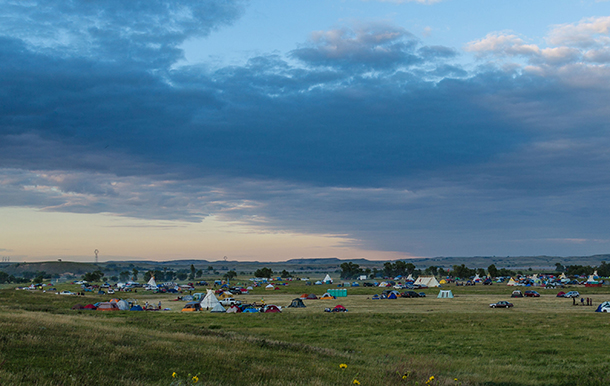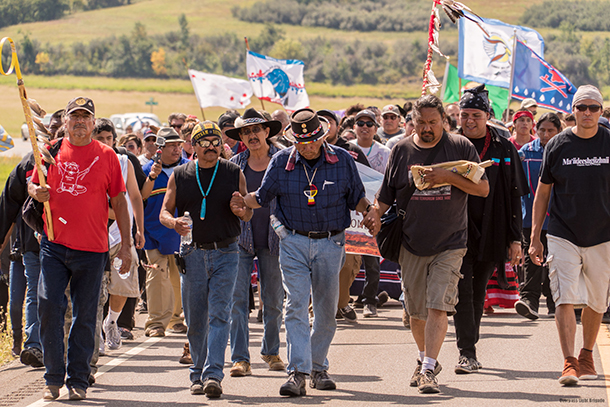Standing Rock And The Feds
Air Date: Week of September 16, 2016

The Sacred Stone Camp where the Sioux and their allies have been camping out in a collective show of dissent for the Dakota Access pipeline project. (Tony Webster, Flickr CC BY-SA 2.0)
After a judge denied a halt to construction of the section of the Dakota Access pipeline that borders the Standing Rock Sioux Nation reservation, three federal agencies issued a joint hold on the portion in dispute. This marks a change in attitude by the federal government concerning Native American rights. Host Steve Curwood turned to Vermont Law School Professor Pat Parenteau to explain the legal basis of this action and what it implies in future.
Transcript
CURWOOD: From the Jennifer and Ted Stanley studios at the University of Massachusetts Boston and PRI, this is Living on Earth. I’m Steve Curwood. When the Obama Administration overrode a federal judge to temporarily halt construction of the Dakota Access Pipeline, it marked a turning point in what is now a mass movement for Native American rights. For years Native Americans have seen their ancestral lands mined, flooded, and appropriated, desecrating holy ground, gravesites and artifacts. And after the Army Corps of Engineers approved the pipeline route through sites revered by the Standing Rock Sioux Nation, it ignited a prairie fire of protest with thousands demonstrating and blocking construction. After a federal judge refused to order a temporary halt of the pipeline on Sept 9th, the Army Corps, Justice and Interior Departments immediately stepped in and suspended the project on federally owned land, and urged the developers to stop work on adjacent private property. To explain the issues at play here, we turn to Vermont Law School Professor Pat Parenteau. Welcome back to the program, Pat.
PARENTEAU: Thank you, Steve.
CURWOOD: So, after the judge decided here, why did the federal agencies step in and intervene?
PARENTEAU: I think the word came down, frankly, from the White House to the Justice Department and to the Corps of Engineers to take another look at this situation. Some evidence had come to light that the company building this pipeline had actually bulldozed sites of extreme importance to the Standing Rock tribe and the news obviously of the protests and some of the violence, some of the security guards had literally sicced dogs on some other protesters. So it looks to me like higher authorities stepped in and said we need to take another look at this case.
CURWOOD: Well, how much of a precedent is this, do you think?
PARENTEAU: I haven't seen anything quite this rapid before where literally within hours of a judge's decision the government completely turned around and said, “We are going to stop the construction that's going on around the crossing of the Missouri River near the tribe's reservation, and we are going to look at this again and maybe do a more full environmental review and also importantly do a better job of consulting with the tribal government.”
CURWOOD: Yes, some of the folks in Indian country are saying this recent action by the Obama administration could turn around literally generations of bad treatment in bad faith. Is this a game changer?
PARENTEAU: I think there are significant implications. I mean, this echoes back to all that that violence around the Wounded Knee occupation, and Native Americans have kind of fallen off the radar screen in terms of politics and in terms of attention. I think this exemplifies that there's a strong feeling within what we call Indian Country that they too are suffering from a lack of respect, a lack of consideration from the federal government, and the fact that there are 120 tribes on site at this point says a lot.
CURWOOD: Remind folks whose memory might not be that long about what happened at Wounded Knee.
PARENTEAU: Right. So this is in the 1970s, early 1970s when this protest movement occurred. The Native tribes all came together and made a stand against what they perceive to be - This is going to have echoes of what we're seeing today with the Black Lives Matter movement - a pattern of abuse from law enforcement were Indians were being singled out for particularly harsh treatment in terms of prosecution, where they were actually forbidden to use some of their Lakota practices which, of course, involves things like Sweetgrass ceremonies and peyote and some other things that might be controversial. But the point is that the Native peoples were saying you know these are parts of our culture our religion and you're curtailing those, and so this was a very strong protest from the Native communities. It ended quite violently with people being killed, people being prosecuted and eventually the federal government taking control for a while.

Demonstrators marching near the pipeline site that’s hotly contested by the Standing Rock Sioux Tribe in court. (Joe Brusky, Flickr CC BY-NC 2.0)
CURWOOD: So what are the broad requirements here that, at least according to the Indians, the Army Corps of Engineers went wrong with?
PARENTEAU: The major one is under the National Historic Preservation Act which protects obviously historic properties, but it also protects archaeological resources, artifacts, including Indian tribal artifacts. There's a lot of that. I mean you can imagine how long the Sioux tribes have occupied these lands. There's graves. There are religious sites. There are historic sites, and this pipeline is running right through the middle of all of that, and there is evidence that some of the bulldozing that was done in a hurry to try to beat the court's decision did in fact destroy some of these of these artifacts.
CURWOOD: So, Pat, how might this affect her future decisions like this?
PARENTEAU: The core of this issue is what's called government to government consultation on major projects like this. And one of the things I noticed when reading the court's decision here is that the judge completely missed the point that, from the tribe's perspective, what they expected to happen was the highest ranking official of the Corps of Engineers - This would be the Colonel in the district office in Omaha Nebraska - They expected the Colonel to reach out to the Tribal Chairman and engage in discussions at that level. Instead what you had is the Corps staff engaging the staff of the reservation and a complete disconnect between the two authorities, and that's at the core of this. The federal government just has to learn that tribes expect a protocol that recognizes their hierarchy and to take advantage of that means of communication. That, I think, is going to change.
CURWOOD: Pat, what was the reasoning that the judge, the district court judge, offered for denying the injunction by the Standing Rock tribe?
PARENTEAU: Yeah, he labored over this. He showed a lot of sympathy towards the tribe. I think he was actually looking for a reason to agree with them, but when he went through the history of sort of miscommunication between the Corps and the tribes he concluded the tribe was as guilty of failing to consult as was the Corps, that the Corps made these various overtures to tribal staff members and didn't get responses, and for a federal judge looking at an administrative record being under the deference doctrine that you're supposed to defer to agencies, he felt he didn't have enough evidence to charge the Corps with violating this consultation requirement. The other thing that he said was the tribe didn't prove, before him at least, that the construction was actually threatening or actually destroying some of their resources. That is called into question by the fact as there are some other indications that there was damage to tribal resources. So it's not entirely clear that the judge had all of the evidence in front of him, that maybe there was, and on appeal it'll be interesting to see what happens with some of that.

Pat Parenteau is an environmental law expert and a professor at the Vermont Law School. (Photo: Vermont Law School)
CURWOOD: Well, look into your crystal ball. What have they offered on appeal and how might the Circuit Court of Appeals look at this, do you think?
PARENTEAU: I think if the tribe is able to convince the Court of Appeals that there is an imminent threat to important tribal resources, they have a good chance of convincing the court to actually issue a stay and an injunction. The scope of that injunction is still open to question, how much of the line...but I think there's enough of a serious question about the Corps’compliance with the Historic Preservation Act, and there's some other laws that apply that as long as the court is convinced that it should step in and stop construction I think there's a good chance it'll do that.
CURWOOD: To what extent is this politics? A presidential election year...Green party presidential candidate Jill Stein has warrant out for her arrest. How political is all of this?
PARENTEAU: Well, you know, it does have overtones of and environmental justice. That does play into the narrative of this particular election campaign where we have disadvantaged people being very upset and angry that the government is not listening to them and not taking care of their concerns, and this is a manifestation of that, I think. This pipeline was originally scheduled to be routed north of Bismarck, which is quite a ways up river from the tribal reservation, and there was an outcry from the citizens in Bismarck, saying,“We don't want a pipeline running near our water supply. Move it.” And so they moved it down to the reservation, and the tribe I think is a legitimate complaint to say, “If it was too dangerous for Bismarck, it's too dangerous for us.”

Thousands across the nation have marched in solidarity with the Standing Rock Sioux Tribe, invoking the popular “keep it in the ground” phrase, which was also used to protest other pipelines such as Keystone XL. (Photo: Peg Hunter, Flickr CC BY-NC 2.0)
CURWOOD: How vulnerable is all this, if the White House changes parties? If Mr. Trump takes the White House as opposed to the Democrat Hillary Clinton?
PARENTEAU: Well, everything's at risk if Mr. Trump wins the election. All of these laws and enforcement of environmental laws…I mean, Trump has already called for abolishing the EPA, so I think that gives you some indication of where he stands on some of these environmental issues, but that's a game changer for sure. If Mr. Trump wins the election, all bets are off in terms of how the federal government honors these commitments to the tribes and probably the other communities.
CURWOOD: Pat, to what extent is all this related to the Keep It In The Ground movement that a number folks are very concerned about doing any more infrastructure to advance fossil fuel resources?
PARENTEAU: I think it's directly related, Steve. We just signed the Paris agreement again, ratified it in the language of international negotiations along with China, and in that agreement we committed to reducing our greenhouse gases by 28 percent by 2030, and the only way you are really meet those commitments is to phase out fossil fuel reliance and infrastructure like this pipeline. That is the bigger story here, is this continued sort of schizophrenia on the part of the federal government on the one hand for the clean power plan trying to reduce emissions and on the other hand granting permits to infrastructure like oil pipelines. They're working at cross purposes and we've got to sort that out.
CURWOOD: Pat Parenteau is a professor of law at the Vermont Law School. Thanks so much for taking the time today, Pat.
PARENTEAU: You're certainly welcome, Steve.
Links
Joint statement from federal agencies
Live updates on lawsuit progress
Living on Earth wants to hear from you!
Living on Earth
62 Calef Highway, Suite 212
Lee, NH 03861
Telephone: 617-287-4121
E-mail: comments@loe.org
Newsletter [Click here]
Donate to Living on Earth!
Living on Earth is an independent media program and relies entirely on contributions from listeners and institutions supporting public service. Please donate now to preserve an independent environmental voice.
NewsletterLiving on Earth offers a weekly delivery of the show's rundown to your mailbox. Sign up for our newsletter today!
 Sailors For The Sea: Be the change you want to sea.
Sailors For The Sea: Be the change you want to sea.
 The Grantham Foundation for the Protection of the Environment: Committed to protecting and improving the health of the global environment.
The Grantham Foundation for the Protection of the Environment: Committed to protecting and improving the health of the global environment.
 Contribute to Living on Earth and receive, as our gift to you, an archival print of one of Mark Seth Lender's extraordinary wildlife photographs. Follow the link to see Mark's current collection of photographs.
Contribute to Living on Earth and receive, as our gift to you, an archival print of one of Mark Seth Lender's extraordinary wildlife photographs. Follow the link to see Mark's current collection of photographs.
 Buy a signed copy of Mark Seth Lender's book Smeagull the Seagull & support Living on Earth
Buy a signed copy of Mark Seth Lender's book Smeagull the Seagull & support Living on Earth

